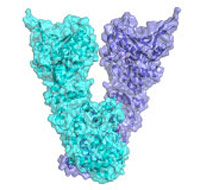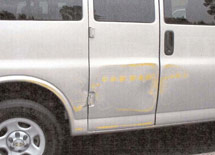 A New Window on
Well-Known Proteins
from SSRL Headlines

A stereo surface view of the GRP94 structure. Researchers from the Hauptman Woodward Medical Research Institute, working in part at The Stanford Synchrotron Radiation Laboratory's Beamline 11-1, have used x-ray diffraction data to confirm a family linkage between the mammalian protein GRP94 and the better known HSP90 proteins, whose functions range from signal transduction to immune response. It is the first high resolution picture of any member of the HSP90 family. Therapies that target GRP94, an essential endoplasmic chaperone (chaperones assist the newly synthesized proteins to achieve their final fold), might play a role in the treatment of immune diseases like sepsis, heart disease, and cancer. The results were published in the October 2007 issue of Molecular Cell.
The structural study and further experiments showed for the first time that GRP94 has a very weak but reproducible ATPase activity. The studies also suggested that the transition from the "twisted V" conformation to one that aligns the catalytic residues was likely to be a key step in the regulation of GRP94 activity. The mammalian member of this HSP90 family is different than those previously studied, which were derived from either bacteria or yeast. The cytoplasmic human Hsp90 exhibits unusually weak ATPase activity, and thus may bear a strong structural resemblance to GRP94. This means that the insights gained by a greater scientific understanding of how GRP94 works will have more direct application to human diseases.
Crystal screening and data collection were carried out using SSRL's user remote-access system, enabling the research group to perform (and control) the experiment from their home laboratory.
Learn more about this research in
SSRL Headline's full scientific highlight.
|
Changes to SLAC
Vehicle Regulations
by Ken Rubino

The results of the latest GSA vehicle accident on SLAC campus. The repair cost has been estimated at $3,700.
During the first quarter of FY08, SLAC's fleet of motor vehicles has experienced an inordinate number of vehicle incidents and accidents—39 of them in total. A good number of these accidents were unreported to Fleet Services at the time of their occurrence. According to Department of Energy (DOE) requirements, any accident involving vehicle damage must be reported to the DOE Site Office on the proper accident form within 24-hours of the accident. To best address these two issues the Fleet Services group has established the following procedures:
• Vehicle custodians are required to perform a vehicle walk-a-round inspection daily. Any body damage, broken lights or bumper damage is to be reported to the Fleet Services office immediately, along with the name of the operator at the time of the accident. Fleet services will take pictures of the damage and assist with filling out the accident report.
• If a vehicle is involved in an accident on the SLAC campus during normal business hours, the vehicle operator must immediately contact the Fleet Services office (x3185 or x8795). Fleet Services will dispatch the fleet manager to take pictures of the accident and assist the operator with filling out an accident report.
• If a vehicle is involved in an accident after normal business hours or over a weekend, the vehicle operator must contact Security at the main gate (x 2551). Security will dispatch an officer to take pictures and assist with the accident report. Security will retain the pictures and the reports and notify fleet services on the next business day. Fleet Services will review the pictures and report, and will forward a copy to DOE Site Office with in 24 hours of notification of accident.
Additional Custodian responsibilities and requirements can be found on the
Facilities Department webpage under "Fleet Services."
In addition, due to tighter budget constraints and stricter vehicle usage requirements from the DOE, minimum utilization justifications have been established.
Read
more...
|






 <%
Response.AddHeader "Last-modified", getArticleDate()
'Response.AddHeader "Last-modified","Mon, 01 Sep 1997 01:03:33 GMT"
'Monday, December 06, 2010
%>
<%
Response.AddHeader "Last-modified", getArticleDate()
'Response.AddHeader "Last-modified","Mon, 01 Sep 1997 01:03:33 GMT"
'Monday, December 06, 2010
%>